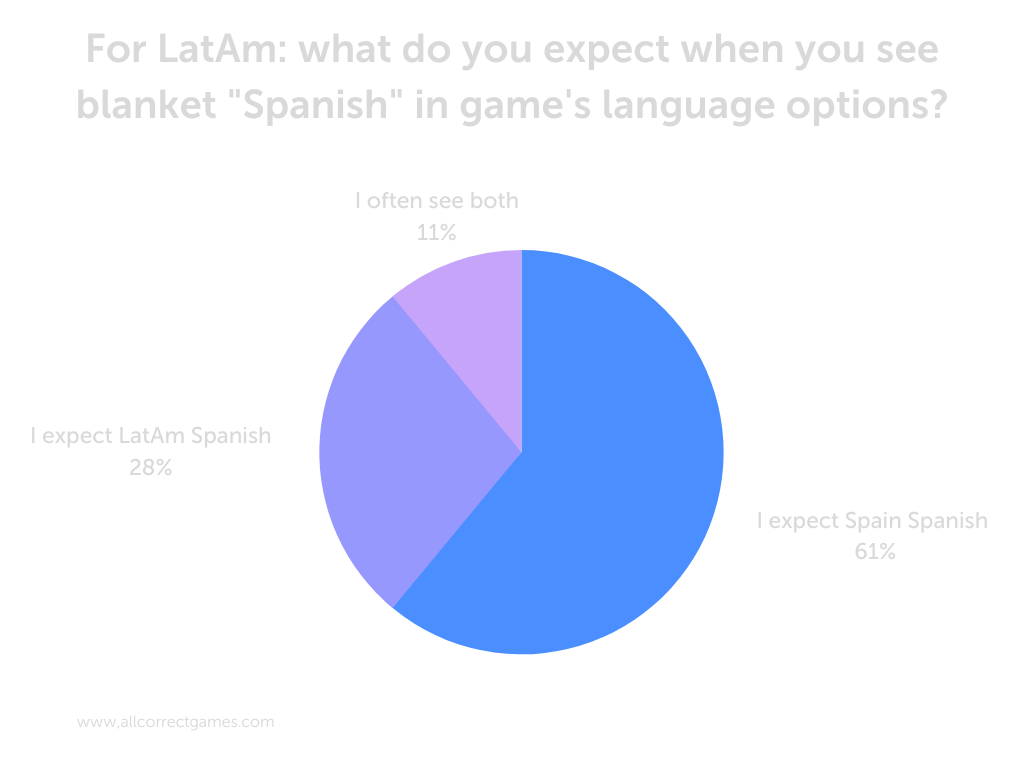We’re often asked which version of Spanish is better to translate a game into—European or Latin American. Let’s take a look!
Market Size
First of all, let’s look at the potential profits that can be made in each of the language markets. In 2021, the gaming market in Spain generated $2.39 billion (according to Newzoo). In Latin America, Spanish is spoken in more than 20 countries, the largest among which are: Mexico ($831.9 million), Argentina ($671.7 million), Colombia ($628.2 million), Ecuador ($120.8 million), Cuba ($83.4 million), Dominican Republic ($57.93 million), Paraguay ($42.36 million), and Uruguay ($33.58 million). And let’s not forget about the Spanish-speaking residents of the United States: Spanish is the second most spoken language after English, and during the 2019 census, more than 41 million people listed it as their native language (13% of the population).
As we can see, the sizes of the markets are comparable. Additionally, the cost of attracting a user from Latin America will be lower than attracting one from Spain.
Our Research
In order to better understand what players want, we conducted a survey among 40 Spanish-speaking linguists from Spain, Mexico, Argentina, Colombia, Chile, and Venezuela. Incidentally, all of the participants in our survey were not only linguists, but also avid gamers. :)
1. Which version of Spanish do you expect to encounter when you just see “Spanish” in a game’s language options?


As you can see, even Latin American residents expect “Spanish” to be the European variety. One respondent also noted that it all depends on the platform. In mobile games, they would expect to find the Latin American version of the language, and on consoles, European Spanish.
2. Do you experience difficulties if the language version in a game is different from the one you are used to?
Speakers of European Spanish said that they often notice a foreign-sounding quality in games that are translated into the Latin American variety. Slang, jokes, and dialectics are often confusing. Faced with the Latin American variety for the first time, even native speakers may perceive an excellent translation as a bad one. In addition, the vocabulary is different, and the meaning of expressions is not always obvious, which is why the language can seem ridiculous to some.
When Latin Americans encounter the European variety in a game, many dialectisms, idioms, and even ordinary phrases may seem amusing to them, even in serious scenes, which somewhat spoils their overall impression. Take, for example, the phrase “I don’t see a thing,” which can be translated into European Spanish as “No veo ni torta,” but for Latin American speakers will mean: “I don’t see any cake.” It’s a seemingly innocuous phrase, but in certain contexts, it can be confusing. Of course, differences in vocabulary play a big role. Also, some Latin Americans don’t like the sound of European Spanish.
As we can see, one size doesn’t fit all.
What’s the takeaway?
Only providing one translation of Spanish will not satisfy players from both Spain and Latin America.
Technically, it is possible to add both versions of the language, even if the default platform only offers one. This is exactly what Blizzard Entertainment has done, for example.



And Bethesda Softworks LLC.


However, it’s difficult to compare localization budgets for AAA projects and indie games. To save money, you can first translate the game into one of the language varieties. If you notice that players are requesting a different version (you can do this by analyzing feedback, for example), you can simply make alterations to existing texts. An editor can go through the European version of the text and correct anything that would be unusual for a Latin American player (grammar, vocabulary, slang). This option will cost the developer less.
We should point out a small nuance: when filling out a project profile on the platform, it’s advisable to avoid using country flags to differentiate languages. This can often be a contentious political issue that may elicit a negative reaction from some users. It’s better to use alphabetic language codes.
Another important thing to note is that so-called Latin American Spanish is a neutral language that is understood by a wide audience in Latin America. It first appeared in the entertainment industry (TV shows and movies), and gradually migrated to games. In fact, no one speaks it: the language of each country in Latin America has its own characteristics.
If you want to understand which version of Spanish is better to translate your game into, write to us. We will conduct a study that will help you decide and choose the right strategy!



